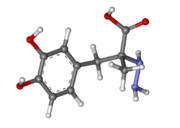Carbidopa
From Proteopedia
(Difference between revisions)
| Line 6: | Line 6: | ||
== Molecular Mechanism == | == Molecular Mechanism == | ||
| - | The conversion of L-DOPA into dopamine is catalyzed by the vitamin B6 (<scene name='pdbligand=PLP:PYRIDOXAL-5-PHOSPHATE'>PLP</scene>)-dependent enzyme DDC, an enzyme abundant in the nervous system as well as kidneys of humans<ref name="three">PMID: 7651438</ref> The catalytically active form of DDC is a homodimer, a feature typical of this class of enzymes<ref name= "four">PMID: 10673430</ref>. DDCs active site is located between the two monomers but is mainly composed of residues from only one of the monomers. The cofactor PLP binds to Lys 303 through a Schiff base linkage and a salt bridge between the carboxylate group of Asp 271 and the protonated pyridine nitrogen of PLP, which acts as a strong electron sink capable of stabilizing the carbanionic intermediates produced by active DDC. the cofactor is further stabilized in the enzyme through a network of hydrogen bonds. Carbidopa works by forming a hydrazone linkage with the PLP cofactor through its hydrazine moiety and blocking the DDC <scene name='74/746001/ | + | The conversion of L-DOPA into dopamine is catalyzed by the vitamin B6 (<scene name='pdbligand=PLP:PYRIDOXAL-5-PHOSPHATE'>PLP</scene>)-dependent enzyme DDC, an enzyme abundant in the nervous system as well as kidneys of humans<ref name="three">PMID: 7651438</ref> The catalytically active form of DDC is a homodimer, a feature typical of this class of enzymes<ref name= "four">PMID: 10673430</ref>. DDCs active site is located between the two monomers but is mainly composed of residues from only one of the monomers. The cofactor PLP binds to Lys 303 through a Schiff base linkage and a salt bridge between the carboxylate group of Asp 271 and the protonated pyridine nitrogen of PLP, which acts as a strong electron sink capable of stabilizing the carbanionic intermediates produced by active DDC. the cofactor is further stabilized in the enzyme through a network of hydrogen bonds. Carbidopa works by forming a hydrazone linkage with the PLP cofactor through its hydrazine moiety and blocking the DDC <scene name='74/746001/Active_site_dopa_final/1'>active site</scene> residues Ile 101' and Phe 103' in the substrate binding pocket with its catechol ring<ref name="five">doi:10.1038/nsb1101-963</ref>. In addition, the 4' hydroxyl group of Carbidopas catechol ring hydrogen bonds with THR 82 and the carboxylate group binds to HIS 192, a highly-conserved residue in PLP-dependent decarboxylases.<ref name="six">PMID: 8889823</ref> Due to the fact that Carbidopa cannot cross the blood-brain barrier, its inhibiting effects only are displayed in the periphery. |
== Disease in Humans == | == Disease in Humans == | ||
| - | Parkinson's disease (PD) is a chronic, progressive neurological disease whose symptoms include bradykinesia, tremors, postural instability and rigidity. Although the exact cause of the disease is currently unknown, it is believe to be caused by the apoptosis of dopanergic cells in the substantia nigra of the brain and subsequent loss of dopamine.<ref name=" | + | Parkinson's disease (PD) is a chronic, progressive neurological disease whose symptoms include bradykinesia, tremors, postural instability and rigidity. Although the exact cause of the disease is currently unknown, it is believe to be caused by the apoptosis of dopanergic cells in the substantia nigra of the brain and subsequent loss of dopamine.<ref name="seven">PMID:10746727</ref> |
Revision as of 18:03, 16 November 2016
Function
| |||||||||||
References
- ↑ Gilbert JA, Frederick LM, Ames MM. The aromatic-L-amino acid decarboxylase inhibitor carbidopa is selectively cytotoxic to human pulmonary carcinoid and small cell lung carcinoma cells. Clin Cancer Res. 2000 Nov;6(11):4365-72. PMID:11106255
- ↑ https://pubchem.ncbi.nlm.nih.gov/compound/carbidopa#section=Top
- ↑ Opacka-Juffry J, Brooks DJ. L-dihydroxyphenylalanine and its decarboxylase: new ideas on their neuroregulatory roles. Mov Disord. 1995 May;10(3):241-9. PMID:7651438 doi:http://dx.doi.org/10.1002/mds.870100302
- ↑ Schneider G, Kack H, Lindqvist Y. The manifold of vitamin B6 dependent enzymes. Structure. 2000 Jan 15;8(1):R1-6. PMID:10673430
- ↑ Burkhard P, Dominici P, Borri-Voltattorni C, Jansonius JN, Malashkevich VN. Structural insight into Parkinson's disease treatment from drug-inhibited DOPA decarboxylase. Nat Struct Biol. 2001 Nov;8(11):963-7. PMID:11685243 doi:http://dx.doi.org/10.1038/nsb1101-963
- ↑ Ishii S, Mizuguchi H, Nishino J, Hayashi H, Kagamiyama H. Functionally important residues of aromatic L-amino acid decarboxylase probed by sequence alignment and site-directed mutagenesis. J Biochem. 1996 Aug;120(2):369-76. PMID:8889823
- ↑ Feany MB, Bender WW. A Drosophila model of Parkinson's disease. Nature. 2000 Mar 23;404(6776):394-8. PMID:10746727 doi:http://dx.doi.org/10.1038/35006074


